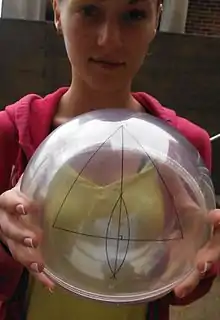Lénárt sphere
A Lénárt sphere is a teaching and educational research model for spherical geometry. The Lénárt sphere is a modern replacement of a "spherical blackboard".[1][2] It can be used for visualizing spherical polygons (especially triangles) showing the relationships between the sides and the angles.

| Education |
|---|
| Disciplines |
| Curricular domains |
| Methods |
Basic set
The Lenart Sphere Basic Set includes:[3]
- A transparent plastic, eight-inch sphere
- A ring-shaped support, called a torus, to place under the sphere
- Hemispherical transparencies that fit over the sphere so that students can draw on these with colored markers and cut out shapes with scissors
- A spherical ruler with two scaled edges for drawing and measuring arcs, angles, and great circles on the sphere
- A spherical compass and center locator for drawing circles on the sphere
- A set of transparency markers for writing and drawing on the sphere and transparencies
- A hanger for displaying your spherical constructions and designs
- A 16-page booklet, "Getting Started on the Lenart Sphere", with activities one can begin as soon as you open the box
- A four-color polyconic projection of the earth that one can cut out and transform into a globe
Related products

Other products for studying spherical geometry include visualization software programs such as The Geometer's Sketchpad, GeoGebra and Spherical Easel [4](see External links for Spherical Easel information, and visit List of interactive geometry software for non-Euclid, and many other interactive Projective geometry apps and programs). Where these products only work on a flat plane, the Lénárt sphere is giving hands-on experience of spherical geometry.
History
The Lénárt sphere was invented by István Lénárt in Hungary in the early 1990s and its use is described in his 2003 book comparing planar and spherical geometry.[5]
Spherical trigonometry used to be an important mathematics topic from antiquity through the end of World War II, and has been replaced in modern education and (in navigation) with more algorithmic methods as well as GPS, including the Haversine formula, linear algebraic matrix multiplication, and Napier's pentagon. The Lénárt sphere is still widely used throughout Europe in non-Euclidean geometry as well as GIS courses.
Spherical tessellation
The Lénárt sphere is useful in modeling and demonstrating spherical tesselation techniques, especially as they apply to finite analysis problems. Using 3D graphics programs or Python code (see external reference link 8 for open source Python code examples vs. NURBS), greater and greater numbers of polygons can be projected to and from the sphere both for analysis of finite elements, and synthesis of objects and features on the sphere, such as the asteroid ridden planet in the example. In this case, the Lénárt sphere is useful for tesselation (tiling) as a simplification or approximation shortcut to the extremely complex differential math of finite analysis and construction (technically: modeling), especially of animated objects.[6]
See also
References
- Van Brummelen, Glen (2013). Heavenly Mathematics: The Forgotten Art of Spherical Trigonometry. Princeton University Press. ISBN 978-0-691-14892-2.
- 60-page preview of Van Brummelen, see p. xiii on Lenart (image redacted on Google)
- "Lenart Sphere". Chartwell-Yorke Maths ICT Store. Retrieved 1 September 2015.
- "Spherical Easel". merganser.math.GVSU.edu. Retrieved 4 February 2018.
- Lenart, Istvan (2003), Non-Euclidean Adventures on the Lenart Sphere: Activities Comparing Planar and Spherical Geometry, Key Curriculum Press, ISBN 978-1559531030
- Mechtley, Adam (2011). Maya Python for Games and Film. Morgan Kaufmann. ISBN 978-0123785787.
External links
- Free download and information on Spherical Easel and other projective geometry educational programs and apps
- Pictures of the Sphere
- Argand Diagram Images
- Argand diagram history
- Copyright-free copy of reference 5
- Copyright-free version of Chauvenet on Astronomy applications
- Open-source Python code for tesselation, nurbs, finite analysis, subdivision surfaces
- Projective Geometry for Machine Vision – tutorial by Joe Mundy and Andrew Zisserman